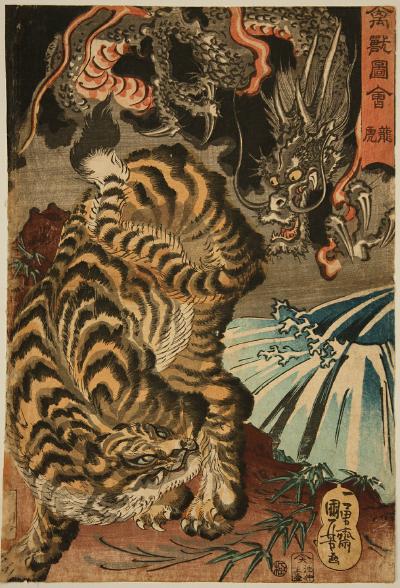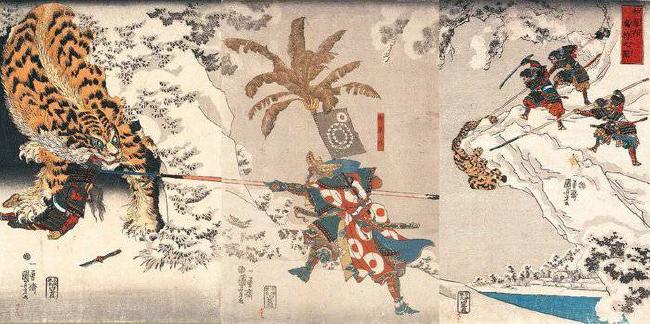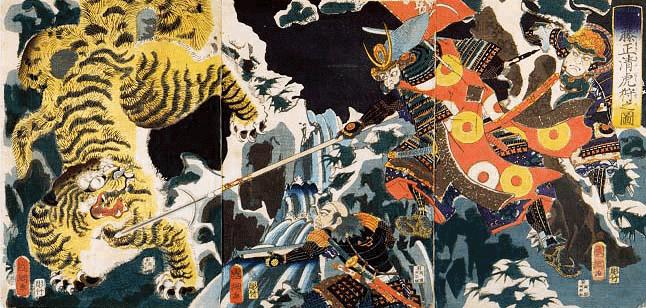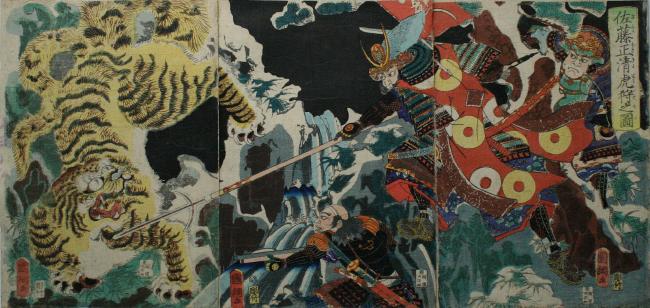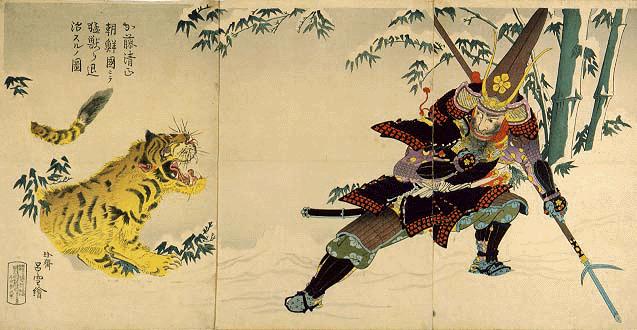Hunting tigers
Subjugating beasts and nations
By William Wetherall
First posted 23 September 2010
Last updated 10 January 2011
Tigers, tigers Birds and beasts | Hunting in China | Hunting in Korea | Sources
Tigers, tigers
One could fill a thick book with nothing but images of Japanese paintings and woodblock prints of tigers as objects of fascination or hunts. Tigers are featured in Buddhist tales, and in Chinese, Korean, and Japanese folklore, and for these and other reasons they rank among the more significant beasts in Japanese pictoral art. They continue to be prominent as one of the twelve branches or animals that figure in the naming of years in the sexegenary cycle. And as icons of commerce, sports, and entertainment, they are found in names of products, a popular baseball teams, and a disbanded singing group.
During the late Tokugawa and early Meiji periods, established drawers and their apprentices cranked out tens of thousands of prints depicting all manner of subjects, including real and imaginary animals. The prints were produced as commodities, but publishers vied with one another to employ popular drawers, carvers, and printers who were skilled in conventional woodblock technology and but also capable of innovating new graphic methods, pigments, and other techniques that would attract attention in printshops.
Drawing a tiger that was appropriately striking -- at once beautiful and terrifying -- was a challenge that virtually all aspiring drawers and carvers had to master as part of their training. Apprentices strived to emulate their teachers, and successful drawers and carvers could probably be ranked according to their mastery of the art of getting the proportions and details of a tiger right.
Birds and beastsKuniyoshi ( F > F 1791-1861), signing as Ichiyūsai Kuniyoshi (źEāV F > źEÖF), drew a series of prints called "Bird and beast pictures" (×b¤š > ×b}ļ Kinjō zue). Each featured one or a pair of animals. They seem to have produced in the early Tenpo years. One shows a horse (n), another a Chinese style lion (q), another a large mythical bird above a lobster (åQ CV), and the one shown here of a dragon and a tiger (“Õ). Antique Arts Morimiya (X{Ćüp / ĆüpąčŻā), in Aichi prefecture, was offering the print for 200,000 yen, which is out of my league. The dealer dated it circa Tenpo 8, or roughly 1837. It bears, to my eye, a seal of the "kiwamein" (Éó) type, which was used between 1791 and 1842. |
Hunting tigers in Korea
During the late Tokugawa and early Meiji periods, established drawers and their apprentices cranked out thousands of prints depicting the legendary feats of heroic figures. The prints flaunted conventional and novel techniques of pictoral representation as forms of graphic entertainment. Not a few prints as objects of fable and lore, but also as animals The TKU Korea print collection includes no less than seven "tiger hunt" prints, four of which are pre-Meiji "Satō Masakiyo" or "Masakiyo" prints.
Kato Kiyomasa
The public website of Tokyo Keizai University Library's Sakurai Bunko collection of Korea-related woodblock prints (see particulars under Sources below) includes seven "tiger hunt" prints, four from the last two decades of the Tokugawa period, and three from the the Meiji period. The hunter on the pre-Meiji prints is Satō Masakiyo or just Masakiyo, while the hunter on the Meiji preints is Kaō Kiyomasa.
In the early 1840s, during the so-called Tenpō Reforms, some officials attempted to censor the sort of lampooning that had become popular among writers and drawers. The reformers soon found themselves out of favor, and themsleves became the object of lampooning. But from this period, conscious of the sensititives of Tokugawa authorities, writers and drawers resorted more to the familiar device of using fictitious names for characters based on historical figures -- both to avoid criticism of misreprestation, and to give them more opportunity for imaginary representation. Savvier consumers of stories, dramas, and color woodblock prints would, of course, recognize that "Satō Masakiyo" was "Katō Kiyomasa".
Katō Kiyomasa (Į”“³ 1562-1611) was one of the general's who led Hideyoshi's invasion of Chōsen (K. Chosŏ) between 1592 and 1598. Kiyomasa, whose childhood name was Toranosuke (ÕV), is supposed to have slayed a tiger in the course of a campaign on the peninsula. The tale of his feat is regarded as folklore, but who knows.
Satō Masakiyo hunting tiger1. The left paw of the tiger is not "encroaching on Japanese territory". Even if the waterfall between the warriors on the right and the tiger on the left is meant to symbolize the Japan Sea, the water cascades cleanly between the two realms. Several of of the "tiger hunt" prints show waterfalls as part of a mountainous landscape. The landscape of this print shows snow on branches of trees and outcroppings of rocks. 2. The large figure in the center who is wielding the spear is obviously the Satō Masakiyo aka Katō Kiyomasa himself. He is the hunter, and the spear he has "aimed at the animals throat" is poised to stab the animal -- not hold it at bay. The object of a "tiger hunt" is, after all, to slay tigers. 3. The print is titled "Satō Masakiyo toragari no zu" (²”³“ÕėV}) or "Drawing of Satō Masakiyo's tiger hunt". It was drawn by Kunitsuna (j) and published by Taihei (å½). The approval seal appears to represent the 7th month of the year of the monkey (\ kō, i.e., kōshin M\) on the lunar calendar, which straddled August and September of 1860 on the Gregorian calendar. |
|||||
Kato Kiyomasa subjugating fierce beast in Chosen1. The print Caprio attributes to "Katada Nagajirō" is titled "Katō Kiyomasa Chōsen-koku ni te mōjū o taiji suru no zu" (Į”“³©NjeŅbŽ”Xm}) meaning "Drawing of Katō Kiyomasa slaying [eliminating, suppressing] a fierce beast in the country of Chosen". Information on the print shows that it was drawn by Chinsai Rosetsu (æāVCį) and published by Katada Chōjirō (Šc·Y). I have not been able to see a clearer copy of the print to verify the publication date, but it may have been 1904. Katada, a carver-turned-publisher, was the third in a succession of carvers who used "Chō" in their signatures, such as Hori Chō (¤·). As a publisher, he produced numerous prints during the last two decades of the Meiji period, when woodblock prints were losing ground to lithography and photography, and drawing and designing prints was a dying trade. Katada put out at least two other Russo-Japanese prints signed by Rosetsu (Cį) -- one depicting a collision of forces in the vicinity Heijō (½é K. P'yŏsŏng) near Heijō (½ė P'yŏngyang), another a naval battle at the mouth of Port Arthur (· Ryojun). |
Sources
I have made extensive use of the following two sources.
Sakurai Bunko at Tokyo Keizai Univeristy
A substantial collection of Korea-related woodblock prints can be viewed as low resolution images at Tokyo Keizai University Library / Digital Archive (oĻåw}ŁEfW^A[JCu). The images are not of especially high quality but are suitable for general study.
The collection is formally known as Sakurai Yoshiyuki Bunko (÷ä`V¶É) or just Sakurai Bunko (÷ä¶É) after the man who donated it to the university. The title of the web presentation of the Korea prints is "Tokyo Keizai University Library Collection / Images of Korea in Ukiyoe Prints Reflecting Meiji Era Stereotypes of Korea" in English. The Japanese title is simply "Tokyo Keizai Daigaku Toshokan / Chōsen nishikie korekushon" (oĻåw}Ł / ©NŃGRNV) or "Tokyo Keizai University / Chōsen nishikie collection".
Sakurai Yoshiyuki (÷ä`V 1904-1989) is best known as a bibliographer. He spent about seventeen years of his life in Keijō in Chōsen. From 1928 to 1941 he worked as an archivist and researcher at Keijō Imperial University. In 1941 he took a position with the documents department of the Government-General of Chosen and became involved in the editing of GGC's organ magazine Chōsen (©N). After World War II, through introductions from people he had known at Keijō Imperial University, he held posts at a number of univeristies in Tokyo as an archivist and a professor of library science and bibligraphy.
Sakurai made part of his personal collection of prints and other materials available to TKU for exhibition in 1974 and the rest in 1984. By 2003 the Korea prints had been filmed to facilitate the distribution of digital images. The website was created in 2004, and the archival project and a link to the website was publicized in Asahi Shinbun on 17 November that year. TKU Library's web database lists a microfilm, of 264 sheets, called "Sakurai Bunko Chōsen Nishikie Shashin Firumu" (÷ä¶É©NŃGŹ^tC) or "Sakurai library Chosen nishikie photographs film".
Kang 2007
The following book by Kang Duksang is the best single volume collection of nishikie related to Korea and China from the late Tokugawa and Meiji periods. The book begins with citation of remarks by Sakarai Yoshiyuki, which amount to Kang's tribute to the bibliographer and collector.
Kang Duksang, compiler and author, et al
Nishikie no naka no Chōsen to Chūgoku
(Bakumatsu / Meiji no Nihonjin no manazashi)
[Korea and China in color woodblock pictures
(The gaze of Bakumatsu / Meiji Japanese)]
Tokyo: Iwanami Shoten, 2007
94 pages, 137 color illustrations, map
B5, softcover, jacket
Though this book is the smaller B5 sizeimages in this book, though not I have reviewed this book as Kang 2007 under Politics in the Topics section of the Bibliography of this website.
